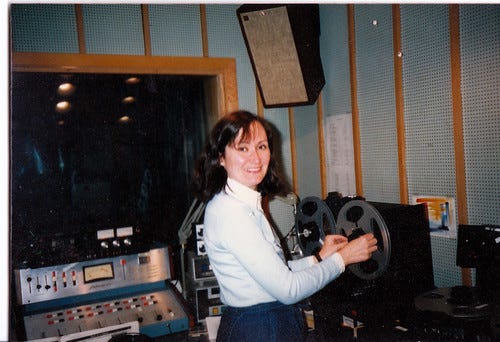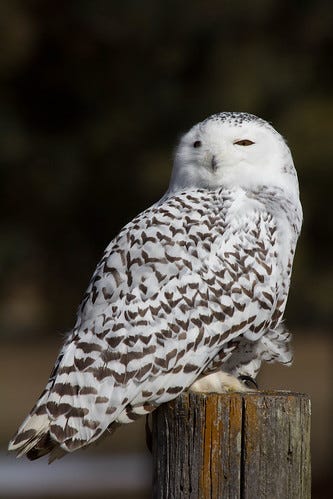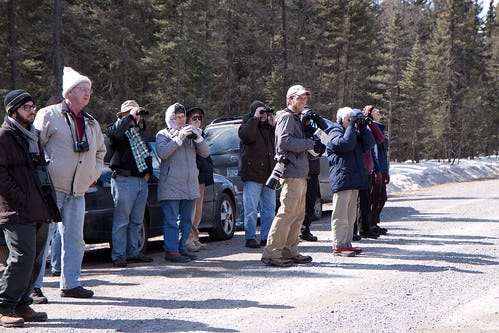(Listen to the radio version here.)
Listening to old radio programs I produced in the 1980s and 90s, it’s disconcerting to realize how much things have changed here around Duluth. Based on my old "For the Birds" programs (in which my voice was much higher and I talked much faster), we could see Snowy Owls pretty regularly just driving on Haines Road toward the mall, and I used to see them often on fences and telephone poles on the way to Port Wing. That hardly ever happens anymore, and in recent years it’s become harder and harder to find them in the harbor area and the Superior Airport, where they were once reliable.
Evening Grosbeaks used to be very common from August or September through April and well into May. We’ve had a few recent years when they were numerous in Duluth—those would be considered standard irruption years—but grosbeaks no longer are regular, common birds in Duluth, which breaks my heart.
Hawk Ridge was famous as the only major raptor count site where Northern Goshawks outnumbered Cooper’s Hawks. Goshawk migration once had fairly a fairly predictable ten-year cycle of “invasions”—the record daily high count of goshawks ever counted at Hawk Ridge was way back on October 15, 1982 when 1068 were counted, and the record seasonal high count went even further back, to 1972, when 4,963 birds were counted from August through November. Both those counts were back in the days before Frank Nicoletti arrived and made our count more systematic and thorough—had someone with his skills and professionalism been counting back in the 70s and 80s, those old counts would have been even higher, making the decline even more obvious.
But not every change since I moved here has been bad. It was once a red-letter day when we saw a Merlin migrating through, but within a few years of my moving here, they started nesting in old crow nests right here in town, and now they’re the main backyard avian predator in Duluth, and represented with much bigger numbers at Hawk Ridge, as well.
Kim Eckert’s wonderful book, A Birder’s Guide to Minnesota, which first came out in 1974 and as of 2022 is now in its fifth edition, made the Sax-Zim Bog internationally famous, and Sparky Stensaas and the Friends of the Sax-Zim Bog organization made this remote area much more accessible to people everywhere, with an excellent system of boardwalks into great birding spots, and feeding stations attracting some of the most beloved bog birds such as Canada Jays and Boreal Chickadees, along with such splendid mammals as ermines, martens, and even the occasional badger or wolf. And every year now, Friends of the Sax-Zim Bog produces a wonderfully detailed birding map of the bog, available online or free at the Visitor Center, and the website provides plenty of useful information about planning a visit. Many birders are hooked into birding networks in which participants send out text messages in real time about rarities, and for those not connected with those, volunteers inside the Visitor Center and a whiteboard just outside the door tells visitors where the most recent “good birds” have been seen.
Those who aren’t confident about driving a remote area of northern Minnesota in the dead of winter on their own can hire a professional guide such as Frank Nicoletti or Erik Bruhnke, or can join others on regular field trips in the bog led by naturalist Clinton Dexter-Nienhaus. There is no evidence that northern owls are increasing at all, yet they are ever so much easier to see now, thanks to all this.
Of course, popularity comes with a steep price. Old-timers like me sometimes miss the days when if we lucked into seeing an owl in the bog, we could enjoy it in peace without constant car-door slamming and birders running in front of us and scaring off the birds, or chatting so much that a stake-out bird stays hidden, even as we appreciate how much easier it now is to find owls in the first place.
Unfortunately, more and more birders are treating the Sax-Zim Bog as if it were a national park or wildlife refuge now when it’s almost entirely private land. The boardwalks into the bog are on land belonging to Friends of the Bog, but the roads through this remote area are not wildlife drives on which people could reasonably be expected to stop whenever an animal appears, blocking traffic and even driveways. Too many visitors don’t realize or care that these narrow dirt roads are the only means of getting around for local residents. More and more I’m seeing birders running right off the road into private land to get better views of owls and other cool wildlife, and even walking along regularly used train tracks—something that is not just illegal trespassing but dangerous. And don’t even get me started on the unethical practices so many visitors to the bog engage in beyond trespassing, such as baiting owls, a practice that every single organization and agency involved with owl conservation condemns with good reason.
The progression of time always means change—for better and for worse. I started out as a cheerful young birder, but again, life is change, so I guess it's natural that I’ve evolved into cranky old Laura Erickson, speaking for the birds.









